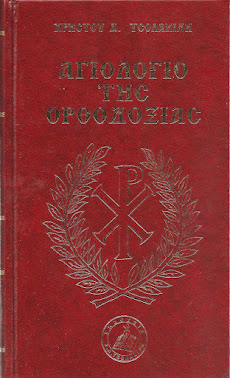Αναζήτηση αυτού του ιστολογίου
Τετάρτη 22 Ιουλίου 2015
ON THE CHURCH by Fr. John Romanides
ON THE CHURCH
by Fr. John Romanides
Our father in the faith, John Romanides (1927-2001), was a prominent 20th century Orthodox Christian priest, theologian, and writer. He argued for the existence of a national, cultural and even linguistic unity between Eastern and Western Romans. This unity existed until the intrusion and takeover of the Western Roman Church (the Roman Catholics) by the Franks and or Goths (German tribes).
The Church is the Body of Christ, which is comprised of all those faithful in Christ; of those who participate in the first resurrection and who bear the betrothal of the Spirit (baptism) or even those who have foretasted theosis (deification).
The Church is both invisible and visible; in other words, She is comprised of those who are enlisted (in active duty) on earth and those who are in the heavens, that is, those who have triumphed (reposed) in the glory of God.
Among the Protestants there prevails the opinion that the Church is visible only—where the sacraments of Baptism and the Divine Liturgy are merely symbolic acts—and that only God knows who the true members of the Church are. The Orthodox Church, on the other hand, also stresses the visible aspect of the Church. Outside the Church, there is no salvation.
The Church as the Body of Christ is the residence of God’s uncreated glory. It is impossible for us to separate Christ from the Church, as it is to separate the Church from Christ. In Papist and Protestant churches there is a clear distinction between the Body of Christ and the Church; that is, one can participate in the Body of Christ without being a member of the Papist Church. This is impossible for Orthodoxy.
According to the Calvinists, after His Ascension, Christ resides in heaven, and consequently the transformation of bread and wine into the actual Body and Blood of Christ is impossible. There is a complete absence of Christ. Approximately the same thing is highlighted in the Papist Church because Christ is regarded as absent, and through the priest’s prayer, Christ descends from the heavens and becomes present. This implies that Christ is absent from the Church. Members of the Church are as mentioned earlier those who have received the betrothal (baptism) of the Spirit.
When the ancient Church referred to the Body of Christ as the Church, and Christ as the Head of the Church, they of course did not mean that Christ was spread out bodily all over the world and that He for example had His Head in Rome, the one hand in the East and the other in the West, but that the whole of Christ exists in every individual Church with all its members, that is, the Saints and the faithful of the universe.
In this way, according to the teachings of the Fathers, when we perform the Divine Liturgy, not only is Christ present, but all His Saints and all the Christians of the Universe are present, in Christ. When we receive a tiny morsel of the consecrated Bread and Wine, we receive all of Christ inside of us. When Christians gather together for the same reason, the whole Church is gathering together, and not just a fraction of it. This is the reason that it has become predominant in Patristic Tradition to refer to monastic Churches in Monasteries as the Katholikon (The Church where the Universal faithful gather).
The destination of all the faithful is theosis (deification). This is everyone’s ultimate objective. This is why a Christian must proceed “from glory to glory;” in other words, the slave must first become a salaried worker, then a son of God and a faithful member of Christ.
There cannot be salvation outside the Church. Christ offers redemptive grace to all people. When one is saved outside the visible Church, it means that Christ Himself has saved him. If he is a heterodox member then he is saved because it was Christ who saved him, and not the religious “offshoot” that he belongs to. His salvation therefore is not affected by the ‘church’ he belongs to, because One is the Church that saves and that is Christ.
Whenever the Orthodox dogma does not exist, the Church is in no position to have an opinion on the authority of the sacraments. According to the Fathers, the Orthodox Dogma never separates itself from spirituality. Wherever there is an erroneous dogma, there is an erroneous spirituality and vice-versa.
There are many who separate the dogma from piety. That is a mistake. When Christ says “become ye perfect, as the Father is perfect” it implies that one must be familiar with the meaning of perfection. The criterion for the authority of the sacraments for us Orthodox is the Orthodox dogma, whereas for the heterodox, it is Apostolic Succession. For the Orthodox Tradition, it is not enough to trace one’s ordination back to the Apostles, but to possess the Orthodox dogma. Piety and dogma are one identity and cannot be separated. Wherever there is upright teaching, there will be upright action. “Orthodox” means a) upright glory, b) upright action. The terrestrial, actively engaged Church is the Orthodox Church. “Orthodox dogma” and “Scriptural teaching” is one and the same thing, because the dogma exists, and it comes from within the Holy Bible.”
Εγγραφή σε:
Σχόλια ανάρτησης (Atom)











Δεν υπάρχουν σχόλια:
Δημοσίευση σχολίου